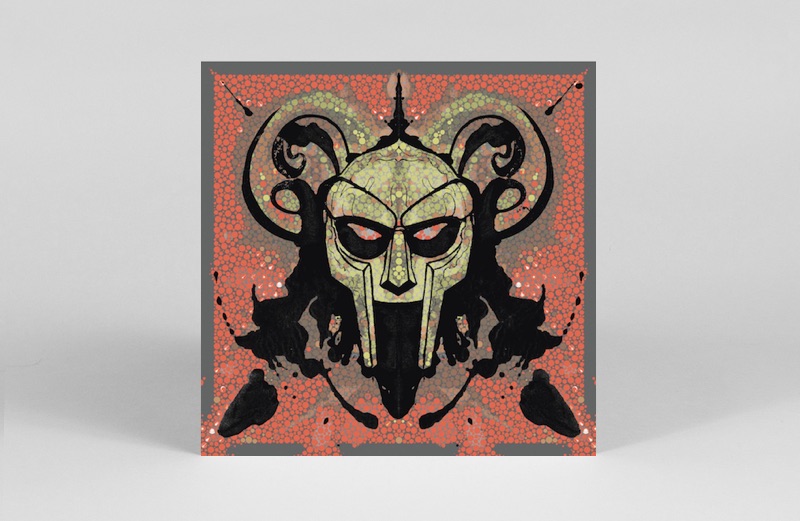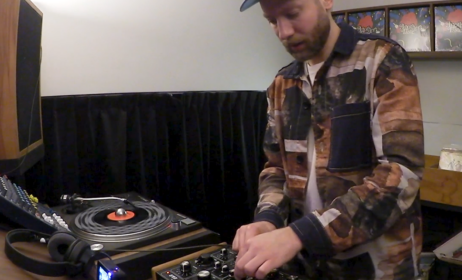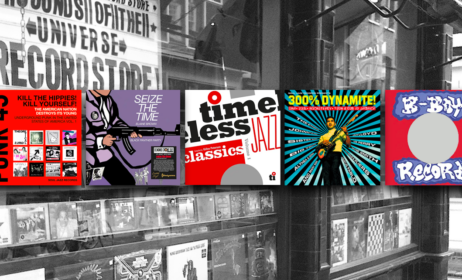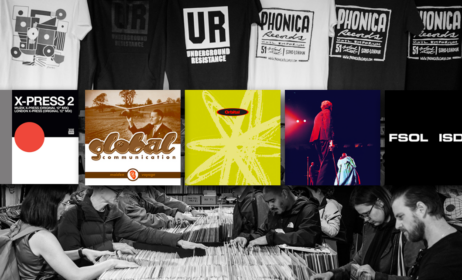Published on
April 27, 2017
Category
Features
Daniel Dumile’s had more names than other rappers have had albums. And with each of those names comes a different facet of his identity, both as a storyteller and a reflection of himself – a reflection obscured by one of the most famous masks in popular music.
He emerged as MF DOOM in the late ’90s and made instant inroads to an indie-rap success, boosted by a mixture of his enigmatic persona-inhabiting unpredictability, a relentlessly quotable and cliche-warping lyrical style, and an uncanny sense of how to make the youthful nostalgia of his ’80s-baby beats and comic book references resonate more deeply and mournfully than the burgeoning “geek culture” had usually allowed. In short, he was diabolically clever and sharp-wittedly funny – but he was also a villain, and villains too often come from tragedy.
DOOM’s tragedies have so often been personal ones, from the circumstances around the loss of both his brother and his promising rap group in the early ’90s to the string of unfinished projects and unreliable live shows that have made his career a frequent minefield.
People often ask “what if” about DOOM, even if he’s already long since given fans more than enough music to ensure a status as one of the all-time underground greats – we know there has to be more, because every time he appears he clicks back into his classic mode, often with a new angle or two, and writes rhymes like he’s literally incapable of using the same thought twice. So few hip-hop artists are more frustrating in their absence and more rewarding when they resurface.
And so few hip-hop artists could have a list of ten records that could be referred to as “a good start” rather than the bulk of their discography. Aside from a handful of fellow iconoclastic multiple-personality workaholics – think the tireless work of DOOM antecedent Kool Keith, or DOOM’s notable brother-from-another-coast collaborator Madlib – you’d be hard pressed to make a list like this feel entirely definitive, especially without some of the stray singles, remixes, EPs, collaborations, crew efforts, and guest spots DOOM’s done in some guise or another since 1989 (!). But just because he’s got rhymes like dimes doesn’t mean they’re a dime a dozen, and if anything this should make a good case for his evolution as one of the strangest and most study-worthy career arcs of his time.
KMD
Mr. Hood
(Elektra, 1991)
To really get a notion of MF DOOM, the complete picture begins with Zev Love X – the name he recorded under during the tragically brief existence of his first group, KMD. Zev Love X first broke through to a golden era rap listenership with his guest spot on 3rd Bass’s ’89 classic ‘The Gas Face,’ a Prince Paul-produced, P.W. Botha-clowning tirade that had the man who would be Metalface twisting around elaborate abstractions like few others this side of Kool Keith.
Mr. Hood arrived two years later, at which point it rivalled only De La Soul Is Dead in its alternately goofy and sharp-witted atmosphere. Afrocentric anti-racist venting (So get this loaded toolie and point it at a ghoul, G/Then ask him “who you callin’ moolie”) segued into conversations with Bert from Sesame Street, rapid-fire comedy skits fused with intricate lyricism until the boundaries between both vanished, and the beats – co-produced by Zev and his brother, DJ Subroc – could make boom-bap funk sound lighthearted and carefree loops sound grimy.
Even when hip-hop was its most deeply infused with both Five Percenter philosophy and anything-goes sample culture, it rarely clicked quite like this. In a happier world, considering how talented Zev and Subroc were despite their youth (neither had yet turned 18 when Mr. Hood was recorded), this could’ve been the start of a Tribe Called Quest-calibre career for KMD.
KMD
Bl_ck B_st_rds
(ReadyRock, rec. 1993, rel. 2000)
This isn’t that happier world. The kayfabe story goes that DOOM was turned into a villain by the machinations of a shady rap industry, but the more detailed reality of the situation is cruelly devastating. The recording and creation of Bl_ck B_st_rds was chaotic enough: MC and third member Onyx the Birthstone Kid left the group mid-production and was cut from early single, sex anthem ‘Plumskinnz,’ while Elektra made a point of butting heads with Zev over the album art he drew of a racist caricature being hung from a gallows.
And then on April 23, 1993, the still-teenaged DJ Subroc was struck and killed by a car when attempting to cross the Nassau Expressway on foot, taking away both a beloved family member and a partner in a musical act that was already on the verge of getting the boot. In an early ’90s timeframe still leery of hip-hop that wasn’t suit-and-tie rap cleaner than a bar of soap, the gun-slinging youthful defiance (‘Get-U-Now’; ‘Gimme’ ) and frequent weed-smoking anthems (‘Contact Blitt’; ‘Smokin’ That S*#%’) only compounded the sense of cold feet that Elektra had about an album that they’d eventually shelve permanently.
It’s a tricky thing trying to calculate how history would have played out if Bl_ck B_st_rds was kept on track for a release that would have added it to hip-hop’s preposterously great run of albums that dropped between late 1993 and late ’94. Still, given its on-edge vibes and its extra-dense, extra-smoky beats, it feels like a presciently strange record, if a challenging one more classically suited to the underground heads that would go on to champion DOOM from his first single onwards.
MF DOOM
Operation: Doomsday
(Fondle’Em, 1999)
The time that lapsed between the disappearance of Zev Love X and the emergence of MF DOOM was sparsely documented, but the effect was obvious: the hyped-up youngster resurfaced in 1997 under the aegis of Bobbito’s underground name-making label Fondle ‘Em as an off-kilter, jaundiced voice that sounded like it aged 15 years in four – and brought a newly veteran-level grip of rhyme dictionary-rewriting punchline lyrics to go with it.
A trio of ’97/’98 singles – including a 12″ that spawned three definitive fan-favorites in ‘Walk on By’-drone ‘Dead Bent’, Steely Dan banger/barrage-flow masterclass ‘Gas Drawls,’ and Scooby-Doo horrorcore caricature ‘Hey!’ – formed the backbone of the first MF DOOM full-length, an album that would set a still-resonant precedent of outlandish alter-ego boasts blurred with grounded observations, comedic wiseassedness that drew ’90s-hardened battle-rap enthusiasts into an album that was often both from-the-heart and to-the-point.
Operation: Doomsday is a stark mic-styles 180 from the old KMD records, where classic rhythmic flow in service of tangled multiple-metaphor lyrics was swapped for straightforward if ingenious lines delivered with disorientatingly off-the-cuff near-conversational timing. His production hits another level, too – the audacious speed-it-up-slow-it-up ‘Glass Onion’ headswim of ‘Tick, Tick…; and the armful of cuts (‘Doomsday’, ‘The M.I.C.’, ‘Red & Gold’, ‘The Finest’) that turn glossy, sumptuous late ’80s/early ’90s R&B into the perfect backdrop for raw spitting.
Viktor Vaughn
Vaudeville Villain
(Sound-Ink, 2003)
Just a few years after his breakthrough as MF DOOM, Dumile was finding new angles to his pseudonym-hoarding existence, from a side-hustle as a Toho Studios kaiju (King Geedorah’s Take Me to Your Leader) to an identity as Viktor Vaughn, an inter-dimensional scientist/rapper who’s depicted as the alternate-universe street-level stick-up kid to DOOM’s reclusive megalomaniac.
That particular alter-alter-ego, especially on Vaudeville Villain (the first of two albums, followed a year later by VV2: Venomous Villain) has the heft of an artist taking a third-person view of some other self, a more surreal and pulpy vision of a career he might’ve had slinging hood rap and killing open mics (literally, in Vik’s case) in some different kind of ’90s where he fell in with Wu-Tang instead of Brand Nubian.
Not that he sacrifices his characteristic style – the persona may change, but the voice and all its diabolical qualities check all the boxes. He just gets a little more aggressive and a lot more willing to get into more long-form track-length storytelling – the botched romantic hook-up of ‘Let Me Watch’ and the ripoff drug deal in ‘Lactose and Lecithin’ are prime examples. And the parallel-life structure’s given extra life with an out-of-character slate of other producers’ beats, including some bombastic ’70s action-thriller vibes from RJD2 (‘Saliva’), herky-jerky mildewed psych from King Honey (‘Mr. Clean’), and Heat Sensor’s insomniac soul jazz (‘Raedawn’).
Madvillain
Madvillainy
(Stones Throw, 2004)
Few first-time/only-time artist-producer teamups in the history of hip-hop blew up quite like Madvillainy. The meeting between DOOM and California’s own Madlib is a real meeting of the (like) minds: like DOOM, Madlib was an alter-ego-sporting producer/MC with an idiosyncratic style and a thing for cinematic and comedic interstitial skits. And yet Madvillainy brought new angles out of both artists, a sort of complementary effort that wound up both amplifying and expanding their respective roles.
DOOM has rarely sounded more quotable, with all-timer lines in pretty much every appearance – with an entire verse’s worth in the choicest cuts, like ‘Money Folder’ and ‘All Caps’ going all killer no filler with that characteristic internal rhyme mastering reel-em-in flow throughout. And while Madlib shines in his on-the-mic cameos – including appearances from his helium-voiced counterpart Lord Quas on ‘America’s Most Blunted’ and ‘Shadows of Tomorrow’ – his production work is the legend-maker here. Hooky and straightforwardly crowdpleasing one moment (hard-thumping, catchy piano jazz loops on ‘Raid’), bewilderingly shaky-kneed and bleary-eyed and lightheaded the next (the gear-grinding horn stabs and disoriented guitar strums of ‘Rainbows’), laced with unpredictable yet immaculately timed narrative interludes from TV specials and blaxploitation flicks and the weirder crevices of dusty old vinyl stacks.
There are so many moments to pinpoint – the titular Daedelus sample of ‘Accordion’, easily one of the weirdest hip-hop beats to ever make an album; the way DOOM remarks Five-hundred somethin’ dollars layin’ right there in the street/Huh, now let’s try and get somethin’ to eat all how-about-that on ‘Curls’; that unexpected moment of Dilla-style, Stacy Epps-laced neo-soul on ‘Eye’ – that it needs some reinforcing that this is a remarkably strong front-to-back whole that can’t and shouldn’t be split into pieces.
MF DOOM
MM..Food
(Rhymesayers Entertainment, 2004)
If Madvillainy is a smoking session, MM..Food is the ensuing trip to the corner store to take care of the munchies. Officially the producer/MC auteur follow-up to Operation: Doomsday (though Madlib and Count Bass D have a couple choice contributions beat-wise), MM..Food is goofy where Madvillainy is witty, and not to its detriment either.
This is a conceptual album-slash-grocery list bookmarked by classic wack MC shit-talk on ‘Beef Rapp’ (Yuck, is they rhymers or strippin’ males/Outta work jerks since they shut down Chippendales) and mutterings about his masturbation habits on ‘Kookies’ (Acting all hard, bout to get beat up/I’ll show him what time it is once I get this sheet up).
Here, he’s a pushing-thirty dirtbag who just happens to be one of the best rappers alive, and even if he uses those skills to spin tales about brew-swigging belligerence (‘One Beer’) or high-level John-robbing pimp game (‘Hoe Cakes’) or not being able to trust anybody (‘Deep Fried Frenz’) his charismatic tendency to drop a slick joke or an agile string of rhymes keeps his villainy lighthearted. It’s also his best collection of self-produced work throughout, all lavish Frankie Crocker-minded smooth fusion jazz and lavish R&B turned grimy just by being in DOOM’s general vicinity. (Try and snag yourself an original pressing, with the superior version of’ ‘Kookies’ that closes out a five-straight album-finishing run of A+ beats.)

Danger Doom
The Mouse and the Mask
(Lex Records, 2005)
DOOM’s Adult Swim-branded team-up with Danger Mouse is a little contentious. The producer was still buzzing off his 2004 Jay-Z/Beatles mashup The Grey Album and the few-months-prior release of Gorillaz sophomore album Demon Days when The Mouse and the Mask dropped, and that put it in rarefied, critically anticipated and acclaimed crossover turf in a way that Madvillainy had done a bit more organically.
Plus, even if there’s already something kind of Space Ghost Coast to Coast in the way DOOM lifted Marvel Comics mythos and other old-school cartoonery into his stoner-friendly portfolio, the appearance of so many first-wave Adult Swim characters (from Brak to Aqua Teen Hunger Force to the cast of Sealab 2021) lays it all on a little thick. Danger Mouse’s beats, heavy on the library-music kitsch-funk and cheerily whimsical overtones, can knock solid but don’t have quite the same air of sordid underground scuzziness as DOOM’s best moments, self-produced or otherwise.
Still, it’s hard to really shut down Metalface when he’s peak sinister wise-ass, where one-liners become three-versers and he never met a truism or an old saying he couldn’t turn on its head and shake down for pocket change. And it’s got one of those scarce, still-fiended-for moments on ‘The Mask’ where we get both DOOM and Ghostface at their peak on the same track. Plus, hey, there’s Cee-lo on a Danger Mouse beat – they really could have something there, huh?
Metal Fingers
Special Herbs the Box Set Vol. 0-9
(Nature Sounds, 2006)
As much as DOOM’s venerated as an MC, he’s arguably underrated as a producer; the fact that the Madlib-produced Madvillainy is generally considered his peak might be considered proof of that. But DOOM’s always been a rarefied crate-digger: funny when he’s obvious (yes, that’s Joe Raposo’s Sesame Street ending jingle ‘Funky Chimes’ in ‘Horehound’), revelatory when he’s obscure (the 9th-round knockout ‘Orris Root Powder’ is a brilliant chop of unsung MPB artist Arthur Verocai), and iconoclastic when he’s familiar (his 2004 flip of the Doobie Brothers’ ‘What a Fool Believes’ preceded their Yacht Rock critical rehab a year before the web video series did).
This ten-LP collection box set‘s easily the most exhaustive collection of DOOM’s beats, gathering up the dozens that were given highlight moments on his own LPs and the dozens more that were either taken up by others (Joey Bada$$ flipped ‘Pennyroyal’ nearly ten years after its Special Herbs Vols. 5 & 6 appearance) or left to float off on their own. The Special Herbs beats have wound up becoming the foundation of entirely new albums on their own – check for the 2003 mashup mixtape Nastradoomus, which recasts post-Illmatic Nas with the vibes of his debut using Special Herbs tracks, or Juice Crew vet Masta Ace’s 2012 MA Doom: Son of Yvonne, where he puts DOOM in the same beat-crafter echelon as Marley Marl.
DOOM
Born Like This
(Lex Records, 2009)
The buzz around Born Like This seems elusive in retrospect, not because the album hadn’t earned it, but because it seemed unclear just where it stood in an end-of-the-aughts hip-hop world. To be fair, just about nobody had the best idea of where anybody stood back in ’09, where the closest there was to a consensus favorite was a toss-up between a comeback record from Raekwon and a comeback record from Mos Def – which, like this comeback record from DOOM (who’d been close to dormant for four years), felt more reassuring than revolutionary.
‘Still Got It’ isn’t a terrible fate, anyways, and there are points on Born Like This that fulfill some hopes and dreams. DOOM never had much of an opportunity to rhyme over J Dilla during the latter iconic producer’s lifetime, so hearing Metalface run rampant on the goth-goes-Moroder psych of ‘Gazillion Ear’ and Donuts choice cut ‘Lightworks; has major appeal and a satisfying chemistry.
Madlib cameo ‘Absolutely’ alternately lurches and glides through that familiar murk that suits both artists perfectly, Jake One drops a handful of no-nonsense cuts that are the closest DOOM’s gotten to clean-fidelity midstream bangers in his career (‘Ballskin’, ‘Rap Ambush’), and DOOM himself goes raw with classic ’80s b-boy breaks (Raekwon feature ‘Yessir!’) and space opera soundtrack love themes (Ghostface teamup ‘Angelz’).
Persona-wise, DOOM seems harsher than usual – ‘Cellz’ invokes a Charles Bukowski apocalypse and envisions his “rancid rants having rambling savages scavenging for scraps, perhaps road kill if that,” ‘Rap Ambush’ has his flow waylaying MCs like a roadside IED, and ‘Batty Boyz’ goes all-in on every cheap homophobic joke ever thrown at superhero comics and/or shirtless thug rappers. In the midst of a late ’00s hip-hop identity crisis that left NYC rap stressed, something this diabolical was inevitable from a self-proclaimed villain.
JJ DOOM
Key to the Kuffs
(Lex Records, 2012)
DOOM’s rep wasn’t at its shiniest at the start of the ’10s. Seems he got the Andy Kaufman-ish idea to try and backstory his way into an excuse for no-showing concerts and sending lip-syncing doppelgangers on stage in his place: these “Doompostors” were simply an expression of his villainous treachery and a greater meta-point about how the identity (or lack thereof) was bigger than the man himself. To say this backfired would be putting it mildly, but it turned out to be a cover for a deeper problem.
Even though he was conceived in the States and had spent the vast majority of his life there starting at a very young age, DOOM was born in London – and United States Immigration figured that since DOOM hadn’t officially applied for citizenship, the end of DOOM’s 2010 European tour would be a fine time to refuse him entry back into America.
That didn’t stop him from being able to make music; the trans-Atlantic exchange of beats with Jneiro Jarel, who he’d previously collaborated with when the East Coast producer cut the track ‘Let’s Go’ as Shape of Broad Minds, built up Key to the Kuffs into a strong team-up, even when the beats stayed a bit low-key.
It’s the undercurrents of that exile from the States, which DOOM still seems hesitant to return to, that give Key to the Kuffs its tone – still cleverly acerbic, but also a bit estranged and alienated. He makes it clearest on ‘Banished’ (Villain got banished/Refused out the U.S., he ain’t even Spanish) before threading a love-hate story about America in through the seams: zeroing in on U.S. government conspiracy theories over pharmaceuticals in the Beth Gibbons-featuring ‘GMO,’ streamlining himself into British life while trying to stay incognito on ‘Borin’ Convo’, and lacing ‘Guv’nor’ with references to environmental disasters brought on by U.S. oil companies. DOOM has had his share of singles, guest spots, and remixes since then – including a reunion of sorts with Madlib, 2016’s ‘Avalanche‘ – but it remains to be seen just how in control of his destiny the supervillain still is.














